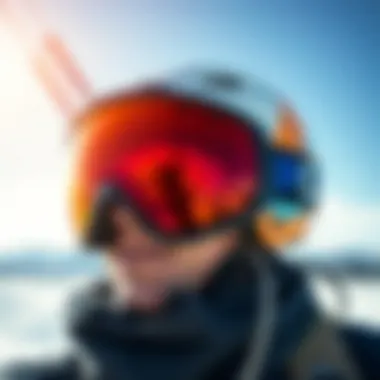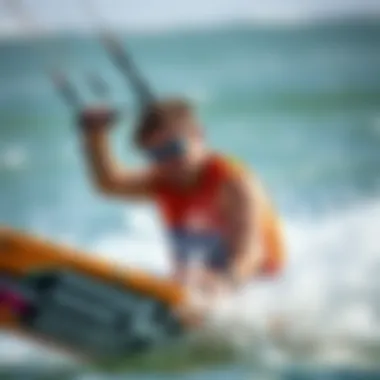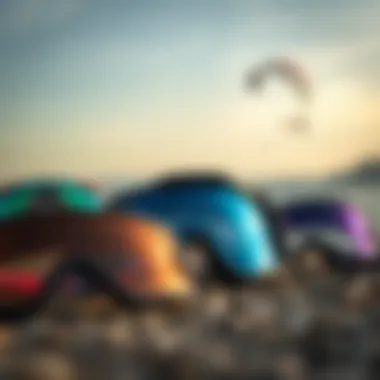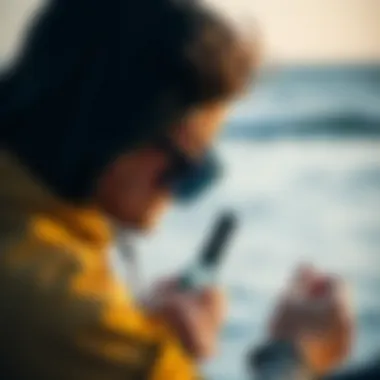Essential Eye Protection for Kiteboarding Enthusiasts


Intro
When you're out there skimming across the waves, kite in tow and salt water splashing, do you spare a thought for your eyes? Sunlight glinting off the water, the wind whipping around—you might think about your board or harness, but your eyes need protection too. This guide doesn’t just skim the surface. We’re diving deep into why protecting your vision while kiteboarding is crucial and how you can do it effectively.
Sailing across the horizon, body in sync with the wind and waves, brings a sense of freedom that few experiences can match. But, with joy comes an array of environmental hazards. From harmful UV rays to debris that can fly up unexpectedly, your eyes are at constant risk during kiteboarding. Not to mention, the glare from the sun hitting the water can be blinding, affecting both your performance and safety on the water.
Understanding the full scope of eye protection goes a long way in enhancing your water adventures. Let's explore why and how to safeguard your vision, making those kiteboarding sessions as enjoyable as they should be.
Understanding Eye Hazards in Surfing and Kiteboarding
When indulging in surfing or kiteboarding, the thrill is often paired with invisible dangers that can affect your vision. One might think about the rush of the waves or the tug of the kite, yet the hazards lurking in the environment warrant a closer look. Understanding these eye hazards is crucial, as it allows enthusiasts to enjoy their time on the water while safeguarding one of their most valuable assets: sight.
Being aware of what you’re up against can empower you to make informed decisions regarding eye protection. Both UV radiation and the reflective properties of water have significant implications on eye health, easily overshadowed by the excitement of the sport. Incorporating knowledge about these dangers into your routine is not just beneficial; it’s necessary for anyone who wishes to pursue kiteboarding or surfing with vigor and safety.
UV Radiation and Its Effects
Ultra-violet radiation is omnipresent when you’re out there riding the waves. The sun’s rays don’t just float above; they penetrate through clouds and bounce off surfaces, meaning you’re exposed even on overcast days. Prolonged exposure to UV rays can lead to a range of eye issues, from cataracts to macular degeneration.
A study conducted by the American Academy of Ophthalmology indicates that repetitive exposure to UV light increases the risk of developing eye conditions later in life. For those who kiteboard or surf, wearing the right protective eyewear can greatly reduce this risk.
It’s recommended that your eyewear should both block out 100% of UVA and UVB rays. Don't just grab any pair of sunglasses off the shelf; look for specifications clearly stating such protection levels. It's the difference between comfort and potential long-term damage.
Water Reflection Impact
Water can be a sneaky adversary. Its reflective nature can intensify sunlight, particularly when the sun is high in the sky. Just think about it: when you’re out kiteboarding, water acts as a mirror, reflecting UV rays directly into your eyes. This reflection can increase the overall exposure level by up to 50%.
Anglers and beachgoers have long been aware of this risk, but many kiteboarders and surfers might overlook it during their sporting activities. The impact isn’t merely a fleeting annoyance but can lead to serious temporary conditions like photokeratitis or snow blindness, which result from corneal damage due to overexposure to UV light.
"A protective pair of glasses isn’t merely an accessory; it’s a shield against daily threats that most won’t see until it’s too late."
For sure, understanding the double-edged sword of sunlight and its reflection off water is imperative. Investing in eyewear that reduces glare while protecting from UV rays can enhance not just your performance but also your experience on the water. More clarity leads to better control, which is essential for safety and enjoyment.
The Importance of Eye Protection
In the realm of kiteboarding and surfing, the thrill of gliding across the water blends seamlessly with the need for safety. One crucial aspect that often gets overlooked is the protection of one’s eyes. As exhilarating as these sports may be, they expose participants to environmental hazards that can have lasting effects on vision. This section sheds light on why eye protection is not just an accessory, but an essential component of any kiteboarding kit.
Benefits of Wearing Eye Gear
The benefits of donning appropriate eye gear during kiteboarding are manifold. Firstly, specialized eyewear helps shield the eyes from harsh UV rays. Long exposure to ultraviolet light can lead to conditions such as cataracts or macular degeneration. You simply can't underestimate the damage this invisible invader can wreak over time.
Moreover, wearing protective eyewear ensures clarity of vision. In the spray of the waves or under the blazing sun, sunglasses or goggles equipped with polarized lenses can reduce glare significantly, allowing you to spot potential hazards in the water. This enhancement is not just about comfort; it can also make the difference between a safe ride and an accident waiting to happen.
Furthermore, wearing the right eyewear can prevent wind and airborne debris from getting into the eyes. When out on the water, a sudden gust can fling sand, tiny fragments, or even saltwater straight into your eyes, which can be both painful and distracting. Eyewear acts as a barrier, giving you peace of mind so you can focus on riding the waves rather than your aching eyes.


Long-term Health Considerations
In considering the long-term health implications of not using eye protection, the stakes become alarmingly clear. Repeated exposure to sun, wind, and water can accumulate over the years, leading to progressive eye diseases.
There’s a subtle yet significant connection between eye safety and overall health. Persistent discomfort or injury could result in a drastic reduction in your quality of life and might even hinder your ability to continue participating in kiteboarding or surfing.
Maintaining good vision is not just about avoiding immediate hazards; it’s about preserving the ability to enjoy these sports in the years to come. Think of your eyes as an investment; protecting them enhances your sustainability on the water. As the saying goes, “An ounce of prevention is worth a pound of cure.” Taking the steps to safeguard your vision today can prevent a plethora of issues down the line, including reduced performance due to impaired sight or chronic discomfort caused by neglected eye care.
In essence, committing to eye protection is committing to your future enjoyment of kiteboarding. Whether you’re an athlete, an instructor, or just a passionate enthusiast, it’s imperative to recognize the value of safeguarding your vision. So gear up, protect your eyes, and keep riding the waves with confidence.
Types of Eye Protection for Kiteboarding
When it comes to kiteboarding, the focus often leans heavily on board skills, wind conditions, and the overall thrill of soaring above the waves. However, one aspect that doesn't get enough airtime is eye protection. Seeking out the right type of eyewear isn’t just a je ne sais quoi of looks, but it’s a bona fide necessity. With knowledge of the harsh elements you're up against—be it UV rays, wind, or splashes—selecting the correct eye protection can make the difference between an exhilarating ride or an eye-popping disaster. In this section, we’ll explore various types of eye protection available to kiteboarders, each with its own unique features and benefits.
Sunglasses: Fashion and Function
Sunglasses aren’t just for looking cool on the beach; they play a vital role in shielding your eyes from harmful UV radiation. Kiteboarding often puts you under direct sunlight for long periods, which can be a real pain in the eyes, literally. High-quality sunglasses featuring polarized lenses reduce glare off the water, allowing you to see better and greatly enhance your focus while riding. When selecting sunglasses, you’ll want to consider factors like:
- Polarization: Cuts through that blinding glare so you can stay sharp.
- UV Protection: Look for lenses that block 100% of UVA and UVB rays.
- Fit and Comfort: Make sure they sit snugly without pinching, a loose fit can cause distraction.
While aesthetics are indeed part of the game, never sacrifice practicality for style. A sleek, sports-oriented pair often strikes a balance between looking sharp and keeping eyes safe. Opt for models designed for active use; these typically feature rubberized ear grips or straps that keep them from going overboard.
Goggles: Optimal Performance
When the wind picks up and the water sprays, goggles might be your best bet for unmatched clarity and protection. Unlike sunglasses, goggles offer a secure fit that helps prevent water from splashing in and fogging up your view. They serve multiple purposes: protecting your eyes from windburn, blocking sand, and keeping your vision unobstructed.
When choosing goggles, consider the following:
- Anti-Fog Coating: This feature ensures your line of sight remains clear through a long session.
- Impact Resistance: Look for materials that can withstand the rigors of both the water and the kiteboarding environment.
- Ventilation: Proper airflow prevents fogging and increases comfort.
Goggles can sometimes come with interchangeable lenses, allowing you to adapt to different light conditions easily. This adaptability can be game-changing when the sun starts to dip and brightness fluctuates. A secure, snug fit, paired with a versatile lens, will keep your vision sharp and your performance top-notch.
Face Shields: Added Protection
Face shields are often an overlooked piece of eye protection but can offer unparalleled advantages in specific kiteboarding scenarios. Particularly in conditions where wind and water combine forcefully, face shields can protect the whole face, shielding against both harsh UV rays and rogue splashes.
Consider these points when looking at face shields:
- Material Durability: Ensure that the shield is made from durable, anti-scratch materials for longevity and safety.
- Visibility: A properly designed face shield should not compromise your peripheral vision. Look for models that curve around without obstructing side views.
- Attachment Flexibility: Quick-release mechanisms or adjustable mounts can offer convenience and ensure they stay put even when you're catching big air.
Face shields often excel in particularly challenging conditions—strong winds, difficult light, or when you’re hitting up a spot known for more aggressive elements. It's about increasing your confidence on the water, so you're focused less on discomfort and more on the art of kiteboarding itself.
"Eye protection isn’t just an accessory; it’s an essential piece of gear that can make your whole kiteboarding experience safer and more enjoyable."


By understanding the varying types of eye protection and their respective advantages, kiteboarders can make informed decisions that significantly elevate their time on the water. As you prepare for your next session, carefully weigh the pros and cons of each option before heading out. Your vision deserves that consideration!
Selecting the Right Eyewear
Choosing the right eyewear for kiteboarding is not just a matter of style, it plays a pivotal role in ensuring safety and enhancing performance on the water. Kiteboarding can expose your eyes to various environmental hazards, including intense UV rays and water glare. Therefore, selecting eyewear that caters to these specific needs is essential for every kiteboarding enthusiast. The right pair of sunglasses or goggles can make or break your experience, transforming your time on the water from a risky endeavor into a delightful journey.
When looking for the right eyewear, there are several things to consider. Comfort is paramount; gear that fits well allows you to focus on your board and the waves instead of discomfort. Additionally, the material and build quality of the eyewear are crucial. Opt for durable frames and lenses that can withstand the rigors of the sea. Remember that you might be in the water for extended periods. Thus, lightweight options can be beneficial, ensuring they stay put through activity. Furthermore, consider features like polarized or photochromic lenses, as these can substantially enhance visibility in bright conditions, making it easier to spot waves and other kiteboarders.
"Investing in the right eyewear can change how you experience the ocean. Your eyes deserve protection against the sun and the surf's reflection."
Features to Look For
When in the market for eyewear that suits your kiteboarding adventures, keep an eye out for specific features that enhance both safety and usability. Here are some critical aspects to evaluate:
- UV Protection: Ensure that your lenses offer adequate UV protection, ideally 100% against UVA and UVB rays. This is essential for safeguarding your eyesight during prolonged exposure.
- Polarized Lenses: These lenses minimize glare from the water's surface, giving you clearer vision and reducing eye strain significantly. This can be particularly beneficial when navigating bright days.
- Wraparound Designs: Opt for glasses or goggles that wrap around your face. This design helps shield your eyes from the wind and water spray, which can be both distracting and hazardous.
- Anti-Fogging Coating: Anti-fog technology is a game changer. It ensures that your lenses stay clear, allowing you to maintain a sharp vision, especially when the humidity rises or when transitioning from cold to warm environments.
- Comfort Fit: Make sure whatever eyewear you choose fits snugly and comfortably to prevent constant adjustments while you ride. Look for soft rubberized nose pads and temples to enhance comfort.
Each of these features contributes significantly to a safer and more enjoyable kiteboarding experience. It is worth taking the time to weigh these aspects critically before making your purchase.
Lens Technologies Explained
In the sea of eyewear options, understanding the various lens technologies can feel overwhelming. However, investing a bit of time in learning these features can lead to better choices. Here’s a breakdown of some popular lens technologies:
- Polarized Lenses: As mentioned, polarized lenses filter out horizontal glare while preserving vertical light. They are excellent for water sports as they boost contrast and clarity, enabling you to spot potential hazards promptly.
- Photochromic Lenses: These lenses adapt to changing light conditions. For kiteboarders who may be out for extended periods, they darken in bright sunlight and turn clear in low-light conditions. This adaptability is invaluable for fluctuating weather.
- Mirrored Lenses: These reflect much of the light that hits the lens surface, offering an additional layer of protection against glare. They'll help keep your eyes relaxed during bright, sunny days.
- Scratch-Resistant Coatings: Protecting your lenses from scratches is paramount, especially in a sport where gear can experience significant wear and tear. Scratch-resistant coatings help maintain clarity over time.
- Anti-Reflective Coating: This coating on the back of lenses can reduce reflections from the inner surface, minimizing distractions and enhancing overall vision through the lenses.
Understanding these technologies can empower kiteboarders to make informed decisions about what works best in their chosen conditions and maneuvers. Knowing what to look for ensures that you select eyewear tailored to your unique needs, thus enhancing your kiteboarding experience.
Maintaining Your Eyewear
Taking care of your eyewear is not just a chore; it's an essential routine that plays a crucial role in extending the life of your protective gear while ensuring your vision remains unimpaired. The right maintenance practices can mean the difference between clear sight and a frustrating day spent squinting against the sun's glare or battling irritating scratches. Since kiteboarding often involves exposure to harsh environments—saltwater, sand, and relentless UV rays—regular upkeep of your eyewear becomes non-negotiable. Not only does proper maintenance protect your investment, but it also enhances your overall performance and comfort on the water.
When considering maintenance, think about it as a two-pronged approach: cleaning and storage. Both aspects work hand-in-hand to preserve the integrity of your eyewear, making them resilient to the rigors of kiteboarding.
Cleaning Techniques for Longevity
One of the most effective ways to ensure your eyewear stands the test of time is through diligent cleaning. Here are some simple steps you can follow to keep your lenses in pristine condition:
- Use the Right Cloth: Always opt for a microfiber cloth specifically designed for eyewear. Avoid paper towels or rough fabrics, as they can scratch the surface of your lenses.
- Lukewarm Water Rinse: Before attempting to wipe your lenses, gently rinse them with lukewarm water. This step ensures that any debris or particles are flushed away, reducing the risk of scratching.
- Mild Soap: For sticky situations caused by sunscreen or salt, a drop of mild soap can work wonders. Just be sure to rinse thoroughly afterward to eliminate any soap residue that could impair visibility.
- Avoid Chemical Cleaners: Many household cleaners contain harsh chemicals that can degrade lens coatings. Stick to products specifically intended for eyewear or simple water.
- Drying: Pat your lenses dry, do not rub them; this minimizes the potential for scratching.
Regularly cleaning your eyewear is akin to sharpening a tool; it keeps your vision clear and enhances your performance on the water.
Storage and Care Tips
Once you've cleaned your eyewear, the next step is to store them properly. Proper storage techniques can go a long way in preventing damage when you're not using them. Here are key considerations for optimal storage:


- Protective Case: Always use a sturdy case to store your eyewear. This acts as a safeguard against accidental drops or compressions when packing them in your gear bag.
- Avoid Direct Sunlight: When not in use, keep your eyewear in a shaded area. Prolonged exposure to the sun can warp frames and diminish lens quality.
- Separate from Other Gear: Avoid tossing your eyewear in with other equipment. When glasses are misplaced with keys or other hard items, the risk of scratches increases significantly.
- Check Regularly: Before heading out, quickly inspect your eyewear for any scratches, chips, or other damages. Taking this extra step can save you from potential hassles down the line.
- Replacement: If you notice severe glares or visibility impeded by scratches on lenses, consider replacing them. It's better to invest in a new pair than to struggle with compromised vision.
In essence, the key to maintaining your eyewear lies in a mix of regular cleaning and thoughtful storage practices. Understanding that your gear requires attention will not only justify your investment but will also enrich your kiteboarding experience, allowing you to focus on what truly matters—enjoying the ride.
Integrating Eye Safety into Your Routine
In the thrill-seeking world of kiteboarding, eye safety is often overlooked. The wind in your hair and the sun on your skin can make perfect conditions for adventure, yet the eyes can take a real beating from UV rays, saltwater spray, and sudden debris. Integrating eye safety into your routine isn’t just smart; it’s essential.
Establishing a habit of wearing suitable eyewear every time you hit the water can prevent immediate discomfort and save you from long-term health issues. Think of it as investing in your next adventure. By making eye protection a non-negotiable part of your toolkit—much like your kite or board—you ensure every ride is not only exhilarating but also safe.
Establishing Safe Practices
Start by creating a consistent routine around eye safety. Before you even hit the waves, check your gear. Ask yourself:
- Are my glasses or goggles in good shape? Look for scratches or cracks. Any damage here could compromise vision on the water.
- Do I have proper UV protection? Look for goggles or sunglasses labeled with UV400 protection. This will block at least 99% of harmful rays, safeguarding your vision.
- Am I aware of changing weather conditions? Overcast days still pose UV risks, and sudden gusts can blow debris at you. Always have your eyewear ready, even if the skies aren’t bright.
Consider also using specialized straps or retainers that keep your eyewear firmly in place. Losing a prized pair of sunglasses to the ocean is disheartening. Last but not least, remember to check your eyewear when you're packing up. A simple rinse with fresh water can help prolong the life of your gear.
Role of Community in Eye Safety Awareness
Kiteboarding is not just an individual endeavor; it's a community sport. Every day, enthusiasts ride the waves side by side, sharing not just the experience but also knowledge about safety practices. It’s vital to foster awareness about eye safety within this community.
Hosting or participating in local workshops or beach clean-ups can be a great way to bring attention to the necessity of protecting your eyes on the water. Consider organizing informal discussions between kiteboarders about their safety practices. Sharing personal stories can be compelling.
"I underestimated the sun’s power, and it cost me my day on the water. I now make it a point to talk to others about eye safety." – A fellow kitesurfing enthusiast.
Furthermore, leverage social media platforms. Create groups on Facebook or threads on Reddit, where people can share recommendations about which eyewear works best under specific conditions. This collective wisdom strengthens the connections in the kiteboarding community, ultimately making it more conscientious about health and safety.
To wrap it up, eye safety is a simple yet crucial part of kiteboarding that shouldn’t take a backseat. Alongside proper gear, healthy practices, and community support, you can ensure that your adventures come with both excitement and security.
The Future of Eye Protection in Watersports
As the world of watersports, particularly kiteboarding, grows and evolves, so does the need for advanced eye protection. The impact of environmental elements like UV rays, wind, and water splashes on eye health cannot be overstated. Understanding the future of eye protection is essential for both enthusiasts and professionals looking to enhance their experience and safeguard their vision.
Innovations in Protective Gear
The next wave of protective gear showcases a blend of technology and functionality tailored to the needs of water sports enthusiasts. Several innovations are already making waves:
- Smart Glasses: Recent developments in smart eyewear integrate augmented reality, giving kiteboarders real-time data on wind speed and wave conditions.
- Anti-Fog and Water-Repellent Coatings: These features are increasingly common, ensuring that the lenses remain clear, even in challenging conditions. Users can focus on their performance rather than constantly wiping their eyewear.
- Eco-Friendly Materials: Many manufacturers are transitioning towards biodegradable plastics and other sustainable materials, which is a huge step towards environmentally responsible kiteboarding gear.
Protective gear that offers these advanced features not only enhances performance but also aligns with the evolving demands for sustainability in our watersports gear.
Sustainability and Environmental Considerations
In today’s climate-conscious world, sustainability is paramount. The way that the industry pivots towards responsible manufacturing practices is not only beneficial for our eyesight but also for the planet. Here are some considerations:
- Production Practices: Brands are acknowledging the environmental burden of fast fashion. Companies that adopt sustainable practices in their production and sourcing reduce their overall ecological footprint.
- Durability and Lifecycle: High-quality protective eyewear can last significantly longer than cheaper alternatives, reducing waste. Investing in durable gear that withstands the elements can lead to fewer replacements and overall less waste production over time.
- Community Initiatives: Engaging in local clean-up efforts or sponsoring initiatives that promote marine conservation can enhance a brand's image and commitment to sustainability. It creates awareness about how the environmental degradation impacts our sports and alerts participants to take action.
"Investing in eye protection that also respects the environment ensures we keep enjoying our beloved activities while being stewards of the planet.“
The future of eye protection in watersports seems bright and full of possibilities. Continuous innovations aligned with sustainability principles will offer kiteboarders the eye gear they need while ensuring they do not compromise the environment. As this field matures, enthusiasts will likely enjoy not only breathtaking views while kiteboarding but also advancements that prioritize their health and the planet.







